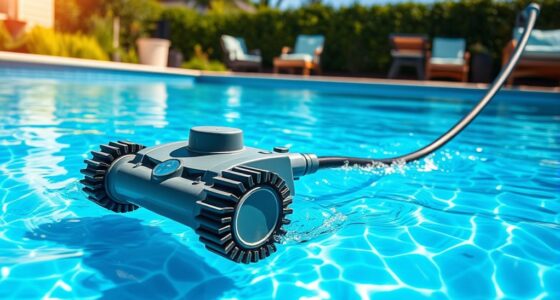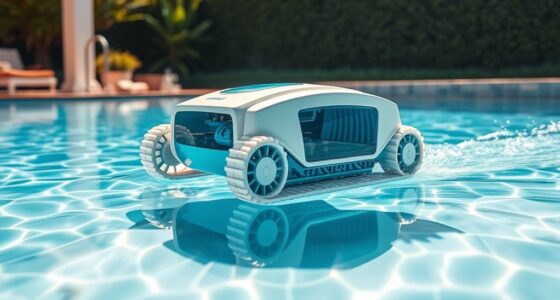When painting a fiberglass pool, the first step is to choose high-quality epoxy paint for long-lasting results. Start by draining the pool completely, cleaning the surface with detergent, and allowing it to dry. Make sure the surface is thoroughly clean, fix any damage, and address any imperfections. Use masking tape to protect the surrounding areas while applying two coats of epoxy paint, with proper drying time between each coat. Allow the paint to cure for 5-7 days, and avoid adding water or chemicals for 3-5 days. Carefully refill the pool, balance the water chemistry, and maintain cleanliness regularly. By following these steps, you will achieve a durable and beautiful finish for your fiberglass pool.
Key Takeaways
- Drain pool completely and clean surface thoroughly before painting.
- Repair any surface imperfections and apply epoxy fillers.
- Use high-quality epoxy paint and apply two coats for durability.
- Allow 5-7 days for epoxy paint to cure and dry completely.
- Refill pool carefully post-painting and balance water chemistry.
Selecting Pool Paint
When choosing paint for your fiberglass pool, always opt for high-quality epoxy paint for its durability and chemical resistance. Epoxy pool paint is specifically designed to adhere to fiberglass pools, providing a long-lasting finish that can withstand the harsh conditions of pool water.
High-quality epoxy paint can last up to 10 years, guaranteeing that your painted fiberglass pool remains vibrant and protected for an extended period. This type of paint creates a watertight seal on the pool surface, preventing leaks and damage that can occur over time.
Pool Draining and Cleaning
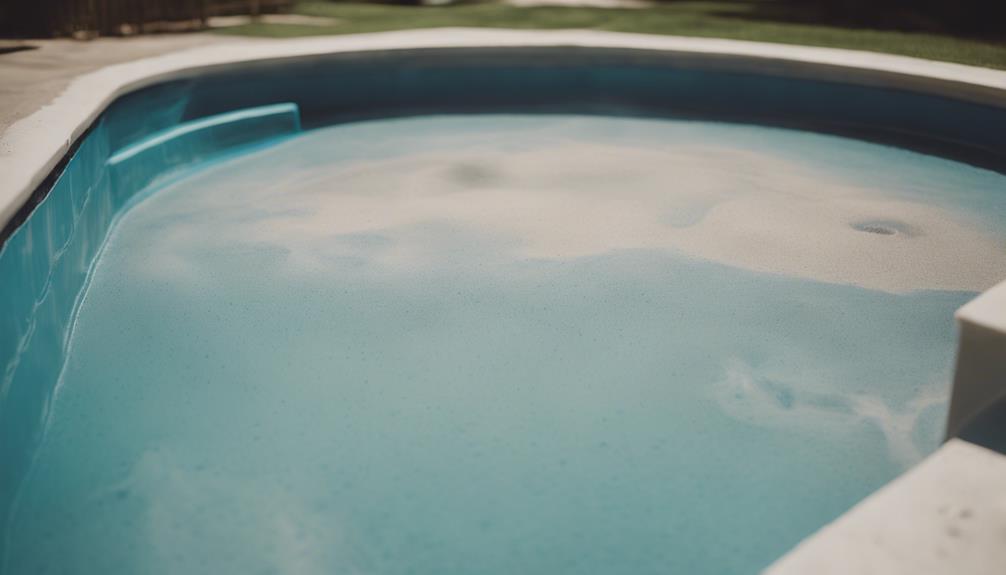
Draining your fiberglass pool completely is an essential step before painting to guarantee proper adhesion of the new paint. Cleaning the pool surface thoroughly is important to remove scale, dirt, and oils that may hinder the paint from adhering effectively. To clean the surface, it is recommended to use dishwasher detergent or TSP degreaser. After cleaning, make sure you rinse the pool surface thoroughly to eliminate any remaining detergent and standing water. Allowing the pool surface to dry for a minimum of 2 days in low humidity conditions is crucial before commencing the painting process. Below is a table summarizing the key steps for pool draining and cleaning:
| Step | Description | Importance |
|---|---|---|
| Draining the Pool | Completely draining the pool before painting | Essential |
| Cleaning the Surface | Using detergent or degreaser to clean the pool | Important |
| Drying the Surface | Allowing the surface to dry for at least 2 days | Essential |
Surface Preparation

To guarantee the surface of your fiberglass pool for painting, start by thoroughly cleaning the entire area to remove any debris, dirt, oils, and fats.
Repair any damage present on the pool surface before sanding it with sandpaper to enhance adhesion for the paint.
This process secures a smooth and durable finish for your pool's new paint job.
Clean the Surface
For best results when painting a fiberglass pool, make sure the surface is thoroughly cleaned to remove any debris, oils, and dirt. Follow these steps to guarantee your pool surface is properly prepared:
- Mix detergent and TSP degreaser in water to create a cleaning solution that effectively removes oils and dirt from the fiberglass surface.
- Scrub the pool surface with the cleaning solution using a brush or sponge to make certain all contaminants are lifted off.
- Rinse the surface thoroughly with clean water and allow it to dry completely before proceeding with the painting process to avoid any adhesion issues.
- Use #80 grit sandpaper to lightly sand the fiberglass surface. This step helps improve paint adhesion by creating a slightly roughened texture for the paint to grip onto.
Repair Any Damage
Inspect your fiberglass pool surface thoroughly for cracks, chips, or any other damage before proceeding with the painting process. Repair any imperfections using a suitable filler or patching compound to guarantee a smooth, flat, and even surface for painting.
It's vital to address any damage adequately as this sets the foundation for a seamless finish and helps the paint adhere better to the surface. By taking the time to repair and prepare the surface, you're ensuring a successful painting project with long-lasting results.
Smooth out the repaired areas diligently, ensuring they're level with the rest of the pool surface. This step is essential in achieving a professional and polished look once the painting process is complete.
Sand for Adhesion
After repairing any damage on your fiberglass pool surface, sanding with #80 grit sandpaper is necessary to create a rough texture for better paint adhesion.
Here are some essential steps to make sure your fiberglass pool is properly sanded for best paint adhesion:
- Sand in One Direction: To avoid uneven surfaces, be sure to sand in one consistent direction. Additionally, hand sand curved areas for precise preparation.
- Prevent Peeling and Flaking: Proper sanding is vital to guarantee the paint adheres effectively, preventing peeling or flaking over time.
- Thorough Rinsing and Drying: After sanding, thoroughly rinse and dry the surface to remove any residual sanding dust or debris that could impact paint adhesion.
- Achieve a Longer-Lasting Finish: The sanding process is essential for helping the paint bond securely to the fiberglass surface, ultimately leading to a longer-lasting finish.
Addressing Cracks and Imperfections
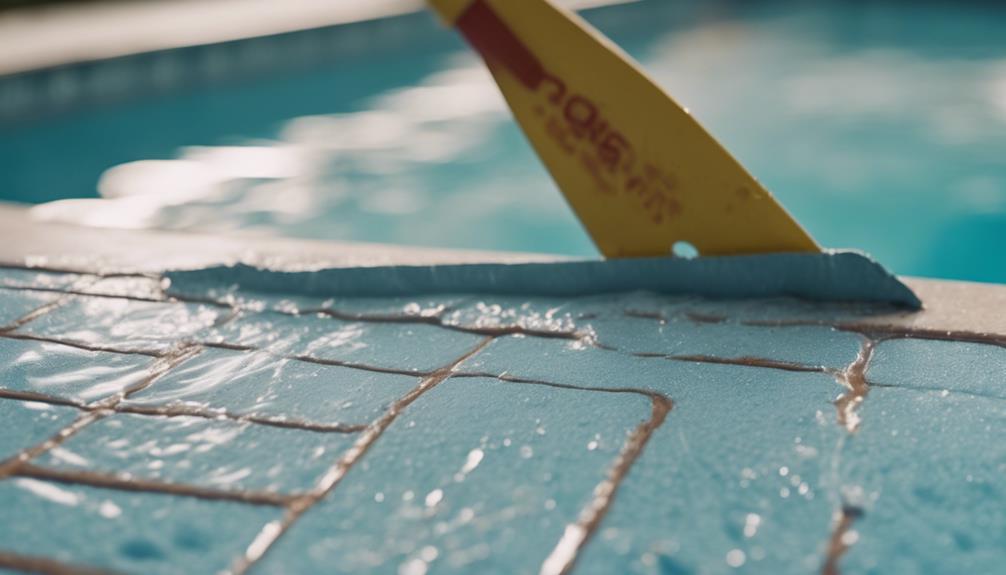
Smooth out imperfections like chips or scratches before painting your fiberglass pool to guarantee a uniform finish. Addressing minor imperfections is vital to achieve a flawless look and maintain a professional finish.
Cracks in fiberglass pools can be effectively repaired using epoxy fillers specifically designed for pool surfaces. By utilizing a fiberglass pool repair kit, you can easily fix these imperfections before applying paint. It's important to have a smooth surface free of any chips or scratches to prevent future issues with the paint job.
Taking the time to properly address these imperfections will result in a long-lasting and aesthetically pleasing outcome. Remember, a meticulous approach to preparing your pool surface will contribute significantly to the overall success of your painting project.
Applying Masking Tape
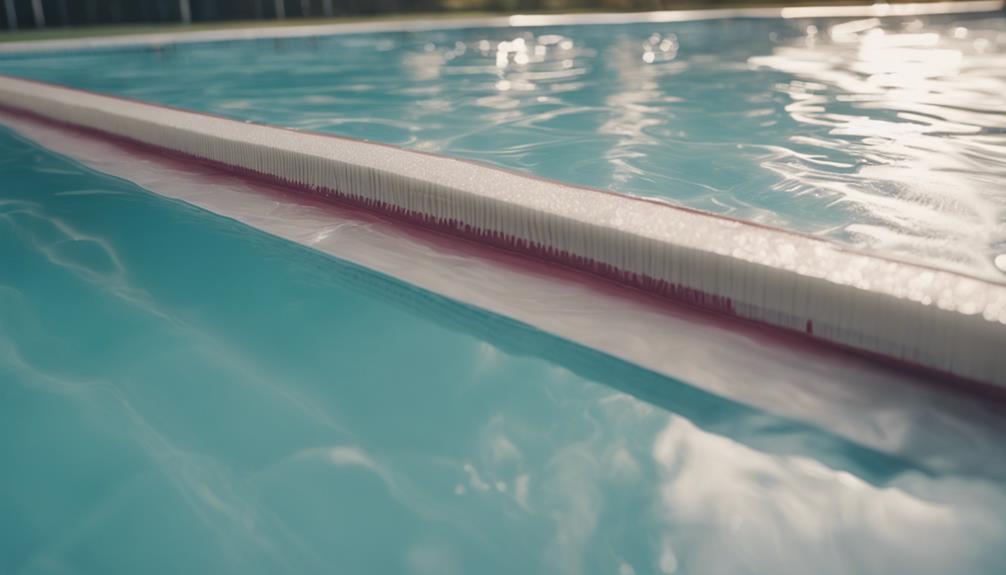
For clean and precise painting results on your fiberglass pool, make sure you use high-quality masking tape designed specifically for painting applications.
When applying masking tape, follow these steps to guarantee professional results:
- Carefully apply the masking tape along the edges of the areas you want to protect, such as tiles or fittings.
- Press down firmly on the edges of the masking tape to create a tight seal and prevent paint from seeping underneath.
- Confirm the masking tape is securely in place before starting the painting process to achieve crisp lines and avoid any paint bleed.
- Remove the masking tape carefully once the paint has dried to the touch but isn't fully cured to prevent peeling off any paint along with the tape.
Applying Epoxy Paint

To achieve a flawless and long-lasting finish on your fiberglass pool, start by properly applying epoxy paint, the ideal choice for its durability and chemical resistance.
Before diving into the painting process, make sure thorough surface preparation by sanding and cleaning the pool. This step is essential to promote adhesion and increase the longevity of the epoxy coating.
When it comes to applying the epoxy paint, remember to coat the fiberglass pool with two layers, allowing sufficient drying time between each coat. This method not only ensures a reliable seal but also enhances the overall durability of the finish.
Typically, epoxy paint requires at least five days to dry completely before refilling the pool with water.
For the best results, consider opting for professional application of the epoxy paint on your fiberglass pool to guarantee flawless outcomes and long-lasting protection.
Curing Time and Drying
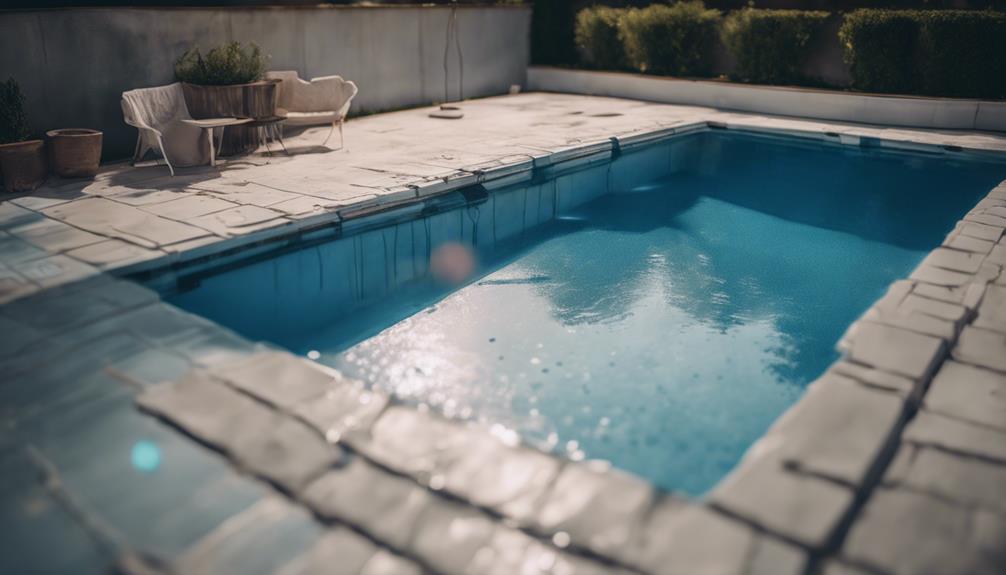
When painting a fiberglass pool with epoxy paint, ensuring the proper curing time and drying process is vital for achieving a durable and long-lasting finish.
Here's what you need to know:
- Epoxy pool paint typically requires 5-7 days to fully cure and dry before refilling the pool.
- Proper drying time is essential to guarantee the paint adheres properly and provides a durable finish.
- Avoid adding water or chemicals to the pool for at least 3-5 days post-painting to allow the paint to set properly.
- Longer drying times, up to 14 days, can improve the quality and longevity of the paint coating.
Following the manufacturer's guidelines for curing time is crucial to maintain the integrity of the paint job on your fiberglass pool. By allowing the paint to dry properly, you can ensure a lasting finish that will withstand the elements and regular pool maintenance.
Pool Refilling and Balancing

Refill your fiberglass pool carefully after painting to prevent damage to the freshly painted surface. Once refilled, it's important to focus on water chemistry to maintain the longevity of your paint job. Test and balance the alkalinity and pH levels of the water post-refilling to make sure that the chemical composition is at its best.
Regularly cleaning the pool surface is also essential to prevent dirt buildup, which can affect the paint's appearance over time. Keep an eye out for any signs of chipping or peeling after refilling the pool, and promptly address these issues to preserve the paint job.
Monitoring chemical balances and promptly removing debris are key steps in maintaining the integrity of the freshly painted surface on your fiberglass pool. By staying proactive in testing, balancing, and cleaning, you can extend the life of your pool's paint job and enjoy a vibrant and long-lasting finish.
Pool Maintenance Tips

Regularly maintaining the water chemistry and cleanliness of your fiberglass pool is crucial for preserving the integrity of its painted surface. To guarantee your pool stays in top condition, follow these maintenance tips:
- Monitor Water Chemistry:
Test and balance chemical levels regularly to safeguard the paint and the pool structure.
- Remove Debris:
Promptly eliminate leaves, dirt, and other debris to prevent staining and maintain the paint's protection.
- Regular Cleaning:
Keep the pool clean by scrubbing the walls and vacuuming the floor to extend the lifespan of the paint job.
- Touch Up as Needed:
Address any chipping or peeling areas promptly with touch-up paint to uphold the appearance and safeguard the fiberglass pool's longevity.
Frequently Asked Questions
How Do You Prep a Fiberglass Pool for Painting?
To prep a fiberglass pool for painting, the first step is to drain it entirely. Next, clean the surface thoroughly with a mixture of dishwasher detergent and TSP degreaser. After cleaning, sand the fiberglass with #80 grit sandpaper to create a rough texture for better paint adhesion. It is important to let the pool dry completely for at least 2 days in low humidity conditions. Once dry, properly tape off non-paintable areas to prevent accidental paint application. These steps are essential for a successful painting process on a fiberglass pool.
What Paint to Use on Fiberglass Pool Steps?
When painting your fiberglass pool steps, opt for epoxy pool paint. This choice guarantees durability and longevity thanks to its protective coating that resists chemicals and abrasions.
Properly prepare the surface beforehand and strictly follow the manufacturer's instructions for application and drying times.
Repainting every 5-7 years maintains both appearance and protection.
Make this informed decision to keep your fiberglass pool steps looking great and well-protected.
What Are the Steps of Painting Fiberglass?
To paint a fiberglass pool effectively, start by sanding the surface with #80 grit sandpaper for paint adhesion.
Apply an epoxy primer before painting for better durability.
Use long, overlapping strokes when applying epoxy paint for even coverage.
Let each coat dry overnight before adding the next layer.
Follow the manufacturer's instructions for the specific epoxy paint used for best results.
These steps are essential for a successful fiberglass pool painting process.
What Are the Steps to Painting a Pool?
When painting a pool, the first steps involve draining, cleaning, and sanding the surface to ensure proper adhesion.
Use high-quality epoxy paint specifically designed for pools. Apply the paint in thin, even coats using long strokes. Allow each coat to dry completely before adding the next layer to enhance durability.
Following the manufacturer's guidelines for maintenance is crucial in preserving the pool's finish. These meticulous steps are akin to a careful artist layering colors on a canvas, resulting in a vibrant and long-lasting pool finish.
Can I Use Pool Paint to Change the Color of My Fiberglass Pool?
Yes, you can use pool paint to change the color of your fiberglass pool. It’s a simple process, and with a few easy tips for blue pool water, you can create a whole new look for your pool. Just make sure to follow the manufacturer’s instructions for the best results.
Conclusion
In conclusion, painting a fiberglass pool can be a cost-effective way to refresh its appearance and extend its lifespan. According to industry experts, fiberglass pools can be painted every 5-7 years to maintain their beauty and integrity.
By following the step-by-step guide outlined above, you can ensure a smooth and successful pool painting project. Remember to consider the type of paint, proper surface preparation, and maintenance tips to keep your pool looking its best for years to come.




